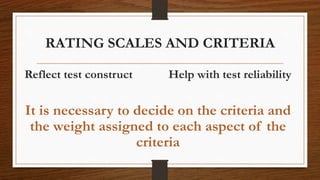Assessing Speaking
- 1. ASSESSING SPEAKING Carmen Mejía C. UNIVERSIDAD TÉCNICA DE AMBATO TEFL GRADUATE PROGRAM – 2016
- 2. THERE ARE SOME KEY QUESTIONS TO ASK YOURSELF Why am I testing? The purpose of the test Who am I testing? Who are the test takers What am I testing? The specific speaking skill (subskill) How am I testing? The different tasks in the test How am I scoring? How to assign marks How is my test benefiting learners? Impact of test in learning
- 3. WHY IS 60 – 70 % USUALLY THE PASSING SCORE? 50% is just half of what they need to know. - 50% is too low. It would not tell what the students know. + 50% will tell in a better way what student knows and what is able to do with the language.
- 4. WHAT MAKES IT DIFFICULT TO TEST SPEAKING? Speaking involves a series of skills and subskills: 1. Generation of ideas 2. The ideas should be converted into words 3. Words are part of knowledge of language which also involves: a. Grammar b. Vocabulary c. Sounds d. Articulation e. Self-monitoring When we speak, we do all this automatically
- 5. DIFFERENT TASKS IN A TEST So that the speaking test is reliable, different tasks should be considered. They should include different aspects: 1. Reproduction Reading texts aloud 2. Monologues Describe a picture, talk about a topic, compare photos, tell or summarize a story, etc. 3. Interaction Questions and answers, discussion, role plays, debates, information gap activities, talk shows, interviews, etc.
- 6. INTERACTION IS THE MOST DEMANDING Paired tasks require higher level of the speaking skill; however, test takers are usually more comfortable since it is done between equals and it resembles real life speaking situations.
- 7. INTERACTION IS THE MOST DEMANDING ASPECT OF A SPEAKING TASK (paired tasks) ADVANTAGES LIMITATIONS • High authenticity • Interactional skills • Role of personality is important (shyness/extroversion may affect interaction) • Age level • Gender • Language ability
- 8. HOW TO ADDRESS LIMITATIONS Make sure test takers have similar levels. Do not use interaction as the only way of testing speaking. Grade the difficulty of the task according to the level. Use analytical and global criteria for scales. Remember there is no «best» way to assess speaking. Each task is good for different purposes. Remember abstract topics are more difficult than concrete familiar topics.
- 9. FACTORS AFFECTING TASK FAIRNESS • Clear instructions • Clear purpose of task • Range of tasks • Order tasks from the easiest to the hardest. • Assign appropriate timing for each part of the test. • Have a clear marking criteria.
- 10. SCORING Can be • NORM REFERENCED when we relate the candidate’s performance according to other candidates taking the same test. • CRITERION REFERENCED when we judge the candidate based on fixed standards.
- 11. RATING SCALES AND CRITERIA Reflect test construct Help with test reliability It is necessary to decide on the criteria and the weight assigned to each aspect of the criteria
- 12. The assessment scale and the criteria are the link between the speech and the score SPEECH ASSESSMENT SCALE AND CRITERIA SCORE
- 13. TYPES OF SCALES: HOLISTIC ANALYTIC General Impression Broken down into separate features: Fluency Pronunciation Vocabulary One overall mark Independent marks for each assessment criterion
- 14. ANALYTIC SCALES HOLISTIC SCALES STRENGTHS LIMITATIONS STRENGTHS LIMITATIONS Diagnostic information Time consuming Practicality: faster, easier No useful diagnostic information Useful in rater training More cognitive demand on administrators Difficult to use when skills are unevenly developed Useful for L2 learners who have an uneven profile
- 15. SUMMARY TO MAKE A TEST FAIR YOU MUST HAVE A clear purpose A suitable test construct A range of task types: the type should match what you want to assess. Appropriate assessment scales and criteria Trained examiners so that the test is reliable















